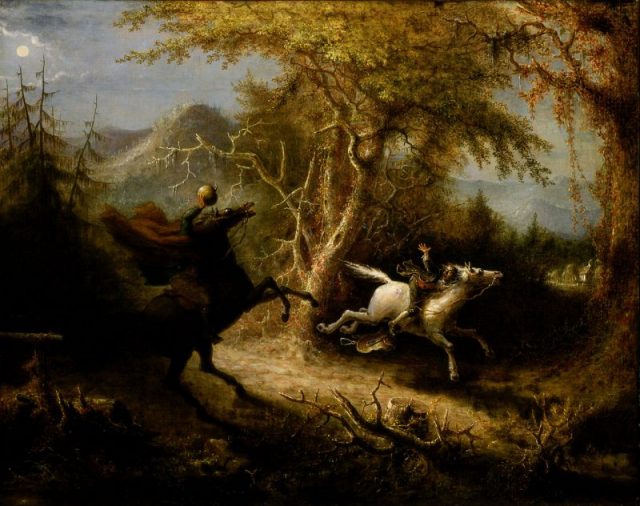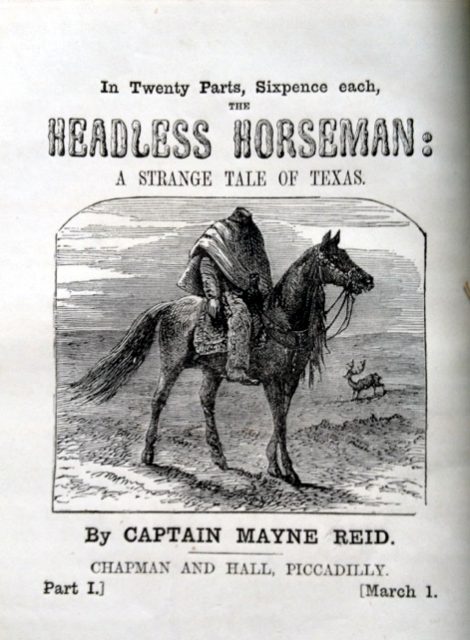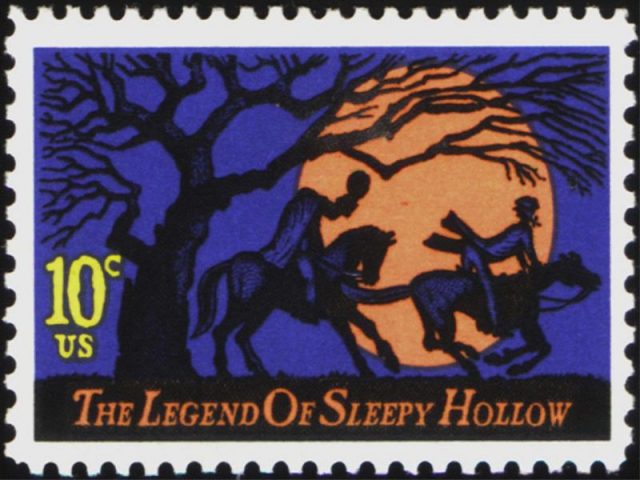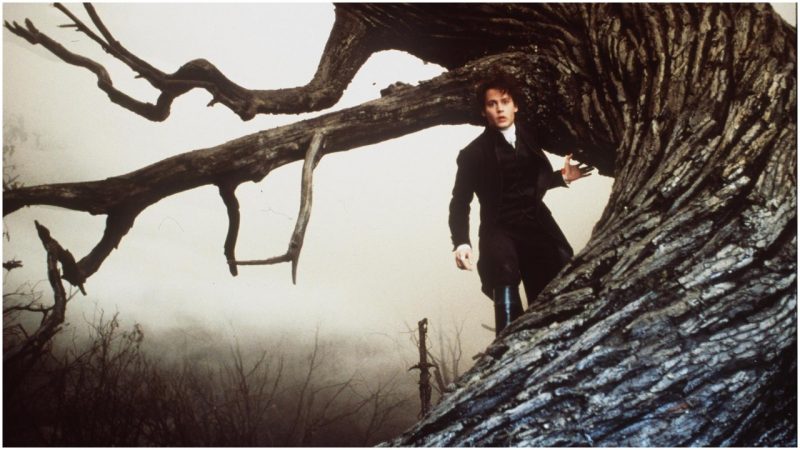“Gigantic in height, and muffled in a cloak, Ichabod was horror-struck on perceiving that he was headless! But his horror was still more increased on observing that the head, which should have rested on his shoulders, was carried before him on the pommel of his saddle!”- Washington Irving, The Legend of Sleepy Hollow.
The 1820s classic tale about Ichabod Crane was penned under ideal circumstances. “Local tales and superstitions thrive best in these sheltered, long settled retreats,” wrote Washington Irving of his story about Ichabod Crane, the slight, smart Oxford schoolteacher and his “face-to-face” rendezvous with a headless horseman.
Irving’s sheltered and long settled retreat was in a small village on the banks of the Hudson River in Westchester County, New York, and therein thrived the legend of a Hessian trooper whose head was taken off by a cannonball during the Revolutionary War. Beheaded and buried headless in Sleepy Hollow’s churchyard, he was believed to hunt the premises at night, desperately searching for his missing head. It was a local favorite superstition. The legend had it that those unfortunate enough to met him were never heard from again.
This wasn’t the first recorded story in the world of a headless horseman. There are a number of these tales in ghost lore; the Brothers Grimm published two such German folk tales from two separate towns. In the tale of Hans Jagendteufel, set near Dresden, in eastern Germany, a woman gathering acorns in a place called “Lost Waters” hears a hunting horn and turns around to see the headless “hunting devil” standing over her. In Brunswick, a “Wild Huntsman” warns hunters not to hunt. If they do decide to go against his will and get to see him in the woods, it’s already too late.
And a few centuries back in time, a writer who preferred to stay anonymous wrote a poem about a gigantic green knight who came to Camelot to test the king’s knights’ loyalty and honor. He dared the men to chop off his head, on condition that the knight brave enough to swing the axe will agree to meet him again in a year and a day and willingly bend his head in front of him to receive an axe blow in return. Not surprisingly, King Arthur was first to volunteer and take on this strange man’s strange challenge. But his nephew, the youngest knight at the round table, proposed to do the deed instead of the King, and with one swift swing he chopped this giant’s head off.

Sir Gawain expected this uninvited guest, now headless, to fall dead to the ground of course. Surprisingly, he just picked his bleeding head up from the ground and reminded the knight about the pledge before riding off on his green horse with his head fixed on the pommel of his saddle.
Sir Gawain and the Green Knight is one of the best known and the most discussed Arthurian stories. It is above all a story of morality, dignity, and honor, yet it’s far from the only one from medieval Europe to mention a headless horseman. In fact, there are at least a dozen tales and legends from the time that mention a headless apparition, most of which came from Scotland and Ireland.
If “local tales and superstitions thrive best in sheltered, long settled retreats,” as Irving put it, these two countries were almost entirely made out of such retreats in the past, and their folklore is one filled with cautionary tales about evil spirits and vindictive fairies. One of them is the legend of the Dullahan, or Gan Ceann, the headless harbinger of death, and he is considered to be the first ever headless horsemen found in history books. No one really knows where or by whom the Dullahan first mentioned, but his existence is bound to an ancient Celtic god, Crom Cruach, the Dark God of the Burial Mound.
According to the legend, about 15 centuries ago Ireland was ruled by the sacred High Kings. They were god-given rulers, and King Tighermas considered himself to be a direct descendant of this dark lord. The god he worshiped demanded human sacrifices to be made in his name each and every year, so land and women could bring life into the next one. He was at the same time the god of death and fertility; this was a death for life sacrifice and Crom Cruach’s preferred method was decapitation.
The Metrical Dindshenchas, a collection of ancient texts, tells us that people from Ireland praised the god upon their king’s request by giving up their firstborn in return for a rich harvest the next year. Children’s heads were smashed on a worshiping stone representing Crom Cruach, and their blood was then spattered around.

Somewhere in the 6th century, according to the legend, St. Patrick found this stone and smashed part of it to pieces. He banished the dark lord to hell and ended this ruthless pagan practice, along with the sacrificial religion. The worshiping stone known as the Killycluggin Stone now sits inside the museum of Cavan County and speaks of the times when St. Patrick brought the Christian faith into Ireland.
The old religion was losing its favor among the people who turned to Christianity instead, but it took a while until they stopped shaking at the thought that the Crom Cruach never died, but just took on a new form. They feared he was still around and was still very much on his agenda to fulfill his yearly quota. In the people’s view, a god so dark could never perish and was harvesting souls one way or another. If not willingly and by sacrifice, then against it, and with wrath and fury. Thus, the legend of the Dullahan, or far dorocha (the dark man) was born.
In Irish folklore, this creature is a type of unseelie (dark) faerie and by description, goals, work ethic and ambition, he seems to be the Celtic equivalent of the Grim Reaper or death personified. Only instead of a scythe, he carries a whip made out of a human spine in one of his hands and his rotting head with a huge jack-o’-lantern grimace in the other. For some, he is the headless rider on a headless black horse, and to others, he rides on a carriage made out of bones, coffins, and tombstones pulled by six fire-breathing headless horses who serve to take death to the poor souls whose time on earth has come to an end. The legend says that if you hear him speak, then he is speaking your name, and unfortunately your time has come to meet him.

Once a name is spoken by the Dullahan, that person could do nothing to stop it and avoid the inevitable. The creature is said was able to overcome any obstacle. Locks and doors open on their own in front of him. Nothing could stand between him and the soul he was after.
Well, according to the legend, the death bringer couldn’t do a thing if the soul he was after simply tossed gold at his feet. Even a small amount, a few coins. For some inexplicable reason, a gold coin was enough to turn death away from his path.
The legends of headless horsemen have existed for more than 15 centuries and are perhaps the best example that good stories, especially cautionary ones, never die but adapt and serve a specific purpose in specific times and cultures.
So while most of us perhaps instantly associate the image of a headless horseman with Christopher Walken’s ghostly face in Tim Burton’s 1999 film adaptation of Irving’s legend, it is nice to know that the haunting specter hunting Jonny Deep as Ichabod Crane in Sleepy Hollow was definitely Celtic in origin. He was not a beheaded Hessian trooper looking for vengeance and his head, but an ancient god to whom gold was his only deterrent, and leprechauns probably his worst enemies.
